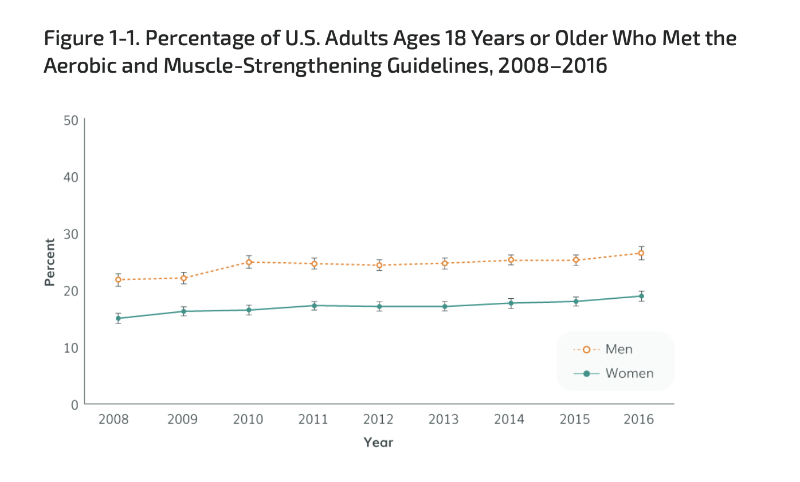We Do Exercise More, But...
According to the surveyed data made public by the CDC and HealthyPeople.gov around 2018, there’s been a gradual increase in the number of people adhering to the recommendations for physical activity and strength training as suggested by the official Physical Activity Guidelines for Americans.

There is no doubt that we have become more health-aware and fitness-inclined in the last decade or two. We have also been observing a noticeable shift in the demographics of those frequenting gyms. The accessibility of online content and the variety of available virtual fitness programs, including YouTube videos or workout apps, have made it easy and convenient for people to try new things and to find something that fits both their needs and their busy, unpredictable schedules. Therefore, we can assume with a high degree of certainty that this reporting must be somewhat valid. So, we do exercise more!
I wanted to point out the fact that, although the first publication of the official Physical Activity Guidelines for Americans came out in 2008, the observed upturn in physical activity among the US adult population can be traced back to earlier dates. According to the data collected by the CDC*, there has been a steady growth in these numbers since 1998 – 10 years prior to the guideline's initial publication date. Therefore, we cannot definitively or fully attribute these results to the release of the aforementioned recommendations.
In addition, similar recommendations were provided in 1995 by the American College of Sports Medicine and the Centers for Disease Control and Prevention, which was over 25 years ago!
If we consider the pace with which modern technology and research in the fields of human physiology, health, and gerontology have been evolving, it is hard to believe that there have been no adjustments in the promoted recommendations. Let’s not dwell on this thought for long, though. As I have already mentioned, there’s an inconceivably long delay when it comes to adopting new scientific discoveries and making them a part of official public health policies. This should give you an idea of how much of a lag that might be.
Let’s say, however, that somehow, over 25 years ago, someone just hit the nail perfectly on the head and we ended up with an ideal set of recommendations that didn’t need any corrections. What was the basis for these recommendations anyways?
According to the committee that compiled the 2018 guidelines for physical activity, the goal was to examine the relationship between physical activity and health, and, later, to develop guidance based on their findings. To quote the text from the publication:
These studies have focused on the role that physical activity plays in many health outcomes, including diseases such as coronary heart disease, stroke, cancer at multiple sites, type 2 diabetes, obesity, hypertension, and osteoporosis; Risk factors for disease, such as overweight or obesity, hypertension, and high blood cholesterol (p. 29).
Great! Now we know that this is an evidence-based plan for addressing these important issues, and we have also confirmed that more people have been complying with these recommendations. It is only logical that we should see a significant shift – whether it’s a slowdown or a full reversal – in the rates of the prevalence of the aforementioned diseases.
We are about to investigate the recently collected data for each of them. Let’s hope that the trends concur with our expectations.
* Participation in leisure-time aerobic and muscle-strengthening activities that meet the federal 2008 Physical Activity Guidelines for Americans among adults aged 18 and over, by selected characteristics: United States, selected years 1998–2017 - https://www.cdc.gov/nchs/data/hus/2018/025.pdf